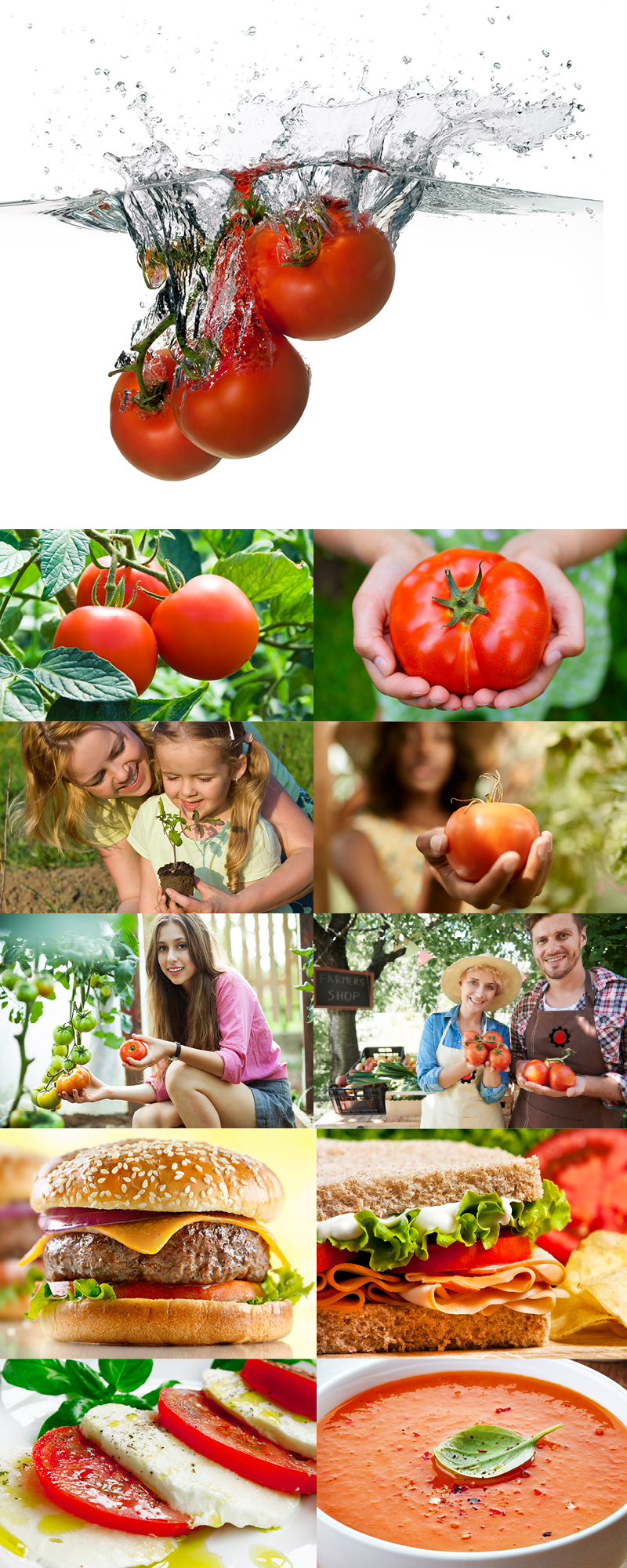
Tomatoes are the best in so many dishes: Salads and pizzas—yep! Salsa, bouillabaisse, ketchup slathered on French fries, tacos, fresh spaghetti sauce, on any sandwich, in drinks. And tossing a tomato on the grill with steaks is a great idea, but you’ve got to see the recipe for grilled tomatoes at the end of this post! It is stupendous!!!! Oh, and you can find that cute baby soup can bunting online, google it. :)))
I may have written about this in the past – but, Yep. You’ve guessed it. Those red, ripe, juicy, tasty, yummy, luscious locally grown tomatoes are in. In all sizes and shapes. And I’m sure loving it. With the hot weather, the farms and shelves are busting with home-grown goodness. I stopped the other day to pick up some fresh corn – then of course I grabbed the beans, and cucs, zucchini, couple peppers, peaches, cherries – ok, so I couldn’t help it. When I got home, I grabbed the knife, some bread, mayo, salt and pepper and loaded up some fat slices of tomatoes and “boom” – summer flavor at its finest. Then you can have the sliced meaty ones covered in a thick blue cheese dressing! I jumped back to my childhood when Mom would fill the table with all the summer vegies and fruits. Here’s some fun trivia, and some even better recipes. I KNOW each of you have your own favorite recipe, so please send my way – especially the salsa and sauce ones!! skowalski@khtheat.com Enjoy! And thanks to tomatodirt.com (amazing site), simplyrecipes.com, feastingathome.com (love that name!) and chefsteps.com for the recipes. Plus a bit of reading music from our friends at YouTube – HERE
- According to the U.S. Department of Agriculture, Americans eat between 22-24 pounds of tomatoes per person, per year. (More than half of those munchies are ketchup and tomato sauce.) I know I do my share in pulling that number up! Remember, ketchup is heart healthy!
- The tomato is America’s fourth most popular fresh-market vegetable behind potatoes, lettuce, and onions.
- Americans consume three-fourths of their tomatoes in processed form and have increased their tomato consumption 30% over the last 20 years (mostly in processed forms such as sauce, paste, and especially salsa).
- While tomatoes are perfectly safe and healthy to eat, their leaves are actually toxic, so don’t eat them.
- The largest worldwide producer of tomatoes is China, followed by USA, Turkey, India and Egypt. Here in the U.S., California produces 96% of the tomatoes that are “processed”. Florida is the number one producer of fresh market tomatoes.
- Tomatoes are thought to originate in Peru. The name comes from the Aztec “xitomatl,” which means “plump thing with a navel”. The scientific term for the common tomato is lycopersicon lycopersicum, which mean “wolf peach.”
- When the tomato was introduced to Europe in the 1500s, The French called it “the apple of love.” The Germans called it “the apple of paradise.”
- In different languages: English: tomato, French: tomate, Dutch: tomaat, German: Tomate, Danish: tomat, Spanish: tomate, Italian: pomodoro (those silly Italians).
- The U.S. Department of Agriculture says there are 25,000 tomato varieties. Other sources cap the number of types of tomatoes at 10,000. (Either way, that’s a lot.)
- Tomato is a cousin of the eggplant, red pepper, ground cherry, potato, and the highly toxic belladonna (a herbaceous perennial, also known as the nightshade or solanaccae, that has historically been used as both a medicine and poison).
- For the best tomato, check color, texture, and touch. A ripe tomato is uniformly colored, in a shade true to its variety. An unripened tomato has inconsistent color. An overripe tomato has soft spots and may ooze juice from cracks. A ripe tomato is smooth, plump, and glossy and not too soft or not too hard to the touch. It “gives” when you press it with a finger.
- The heaviest tomato on record weighed in at 3.51 kg (7 pounds 12 ounces). A “delicious” variety, it was grown by Gordon Graham of Edmond, Oklahoma in 1986. Gordon sliced the tomato to make sandwiches for 21 family members.
- The largest tomato plant (a “Sungold” variety), recorded in 2000, reached 19.8 meters (65 feet) in length and was grown by Nutriculture Ltd. of Mawdesley, Lancashire, UK.
- According to the Guinness Book of World Records, the largest tomato tree grows at Walt Disney World Resort’s experimental greenhouse and yields a harvest of more than 32,000 tomatoes and weighs 1,151.84 pounds (522 kg). The plant was discovered in Beijing, China, by Yong Huang, Epcot’s manager of agricultural science, who took its seeds and grew them in the experimental greenhouse.
- Tomato juice is the official state beverage of Ohio – (right behind Bud Light).
- La Tomatina (Bũnol, Valencia, Spain), held festival held annually on the last Wednesday in August, attracts tens of thousands of visitors. The highlight is the tomato fight, in which 30,000+ participants throw an estimated 150,000 overripe tomatoes (100 metric tons) at each other.
- TomatoFest (Carmel, CA), coined as “America’s Favorite Tomato Festival,” was launched in 1991 and features 350 heirloom tomato variety tastings.
- In Ohio, the big one is the Reynoldsburg Tomato Festival. Started in 1965, the festival honors Reynoldsburg’s claim to fame as the birthplace of a sweeter, edible tomato created by resident Alexander W. Livingston. In 1870, he was the first to upgrade the wild tomato plant. (sorry, cancelled this year).
- The antioxidant lycopene is a red pigment found in tomatoes. Tomatoes with the most brilliant shades of red indicate the highest amounts of lycopene and its fellow antioxidant, beta-carotene.
- Cooking tomatoes releases lycopene to do its work. A combined analysis of 21 studies published in Cancer Epidemiology Biomarkers and Prevention showed that men who ate the highest amounts of raw tomatoes had an 11% reduction in risk for prostate cancer. Those eating the most cooked tomato products fared even better: their prostate cancer risk was reduced by 19%.
- Lycopene is fat-soluble. That means you’ll get the maximum benefit of tomato nutrition when tomatoes are absorbed in your body with the help of fats. Cook tomatoes in a touch of olive oil or pair tomatoes with avocados (in small amounts) to help your body absorb lycopene more easily. I have been trying to find the health benefits of French fries covered in ketchup!!
- Eating tomatoes regularly is also good for your heart – one of the leading benefits of tomato nutrition. In a study of 40,000 women conducted at Brigham and Women’s Hospital (Boston, MA), those who consumed 7 to 10 servings each week of tomato-based products were found to have a 29% lower risk of cardiovascular disease compared to women eating less than 1.5 servings of tomato products weekly.
- Eat 1.4 cups of raw broccoli and 2.5 cups of fresh tomato (or 1 cup of tomato sauce or ½ cup of tomato paste) daily to get best tomato nutrition benefits. According to a study in Cancer Research, the tomato-broccoli combination shrank prostate tumors in lab animals by 52%.
Q: Why did the tomato go out with a prune?
A: Because he couldn’t find a date.
Q: How do you fix a sliced tomato?
A: Use tomato paste, of course.
Q. Why did the tomato blush?
A. Because he saw the salad dressing.
Q. What’s the difference between knowledge and wisdom?
A. Knowledge is knowing a tomato is a fruit; wisdom is not putting it in a fruit salad.
Q. How do you get rid of unproductive tomatoes?
A. Can them.
Fresh Salsa – Pico de Gallo
Fresh Tomato Sauce
Fresh Grilled Tomatoes
Steve’s Fresh Tomato Sandwiches
– big, thick slices of fresh summer tomatoes, spread mayo on soft bread, salt & pepper – (ta-da!)
::::::::::::::::::::::::::::::::::::::::::::::::::::::::::::::::::::::::::::::::::::::::::
DO YOU LIKE CONTESTS?
Me, too.
As you may know the Kowalski Heat Treating logo finds its way
into the visuals of my Friday posts.
I. Love. My. Logo.
One week there could be three logos.
The next week there could be 15 logos.
And sometimes the logo is very small or just a partial logo showing.
But there are always logos in some of the pictures.
So, I challenge you, my beloved readers, to count them and send me
a quick email with the total number of logos in the Friday post.
On the following Tuesday I’ll pick a winner from the correct answers
and send that lucky person some great KHT swag.
So, start counting and good luck!
Oh, and the logos at the very top header don’t count.
Got it? Good. :-))))
Have fun!!
::::::::::::::::::::::::::::::::::::::::::::::::::::::::::::::::::::::::::::::::::::::::::






